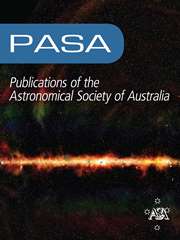No CrossRef data available.
Article contents
The Rise of the Milky Way Disk through EMP Stars
Published online by Cambridge University Press: 20 March 2025
Abstract
We present a chemo-dynamical study conducted with 2dF $$ + $$AAOmega of
$$ + $$AAOmega of  $$ \sim 6000$$ Gaia DR3 non-variable candidate metal-poor stars that lie in the direction of the Galactic plane. Our spectral analysis reveals 15 new extremely metal-poor (EMP) stars, with the lowest metallicity at
$$ \sim 6000$$ Gaia DR3 non-variable candidate metal-poor stars that lie in the direction of the Galactic plane. Our spectral analysis reveals 15 new extremely metal-poor (EMP) stars, with the lowest metallicity at  $$\left[ {{\rm{Fe/H}}} \right] = - 4.0 \pm 0.2$$ dex. Two of the EMP stars are also carbon enhanced, with the largest enhancement of
$$\left[ {{\rm{Fe/H}}} \right] = - 4.0 \pm 0.2$$ dex. Two of the EMP stars are also carbon enhanced, with the largest enhancement of  $$\left[ {{\rm{C/Fe}}} \right] = 1.3 \pm 0.1$$ occurring in a dwarf. Using our
$$\left[ {{\rm{C/Fe}}} \right] = 1.3 \pm 0.1$$ occurring in a dwarf. Using our  $$\left[ {{\rm{C/Fe}}} \right]$$ results, we demonstrate that the number of carbon-depleted stars decreases with lower metallicities, and the fraction of carbon-enhanced stars increases, in agreement with previous studies.
$$\left[ {{\rm{C/Fe}}} \right]$$ results, we demonstrate that the number of carbon-depleted stars decreases with lower metallicities, and the fraction of carbon-enhanced stars increases, in agreement with previous studies.
Our dynamical analysis reveals that the fraction of prograde and retrograde disk stars, defined as  $${z_{{\rm{max}}}} \lt 3$$ kpc, with
$${z_{{\rm{max}}}} \lt 3$$ kpc, with  $${J_\phi }/{J_{{\rm{tot}}}} \gt 0.75$$ and
$${J_\phi }/{J_{{\rm{tot}}}} \gt 0.75$$ and  $${J_\phi }/{J_{{\rm{tot}}}} \lt - 0.75$$ respectively, changes as metallicities decrease. Disk stars on retrograde orbits make up
$${J_\phi }/{J_{{\rm{tot}}}} \lt - 0.75$$ respectively, changes as metallicities decrease. Disk stars on retrograde orbits make up  $$ \sim 10$$% of all the stars in our sample with metallicities below
$$ \sim 10$$% of all the stars in our sample with metallicities below  $$ - 2.1$$ dex. Interestingly, the portion of retrograde disk stars compared with the number of kinematically classified halo stars is approximately constant at
$$ - 2.1$$ dex. Interestingly, the portion of retrograde disk stars compared with the number of kinematically classified halo stars is approximately constant at  $$4.6$$ % for all metallicities below
$$4.6$$ % for all metallicities below  $$ - 1.5$$ dex. We also see that
$$ - 1.5$$ dex. We also see that  $${J_\phi }$$ increases from
$${J_\phi }$$ increases from  $$380 \pm 50$$ to
$$380 \pm 50$$ to  $$1320 \pm 90$$ km s
$$1320 \pm 90$$ km s $${^{ - 1}}$$ kpc across metallicity range
$${^{ - 1}}$$ kpc across metallicity range  $$ - 1.5$$ to
$$ - 1.5$$ to  $$ - 1.1$$, consistent with the spin-up of the Galactic disk. Over the metallicity range
$$ - 1.1$$, consistent with the spin-up of the Galactic disk. Over the metallicity range  $$ - 3.0 \lt \left[ {{\rm{Fe/H}}} \right] \lt - 2.0$$, the slopes of the metallicity distribution functions for the prograde and retrograde disk stars are similar and comparable to that for the halo population. However, detailed chemical analyses based on high resolution spectra are needed to distinguish the accreted versus in-situ contributions. Finally, we show that our spectroscopic parameters reveal serious systematics in the metallicities published in recent studies that apply various machine learning techniques to Gaia XP spectra.
$$ - 3.0 \lt \left[ {{\rm{Fe/H}}} \right] \lt - 2.0$$, the slopes of the metallicity distribution functions for the prograde and retrograde disk stars are similar and comparable to that for the halo population. However, detailed chemical analyses based on high resolution spectra are needed to distinguish the accreted versus in-situ contributions. Finally, we show that our spectroscopic parameters reveal serious systematics in the metallicities published in recent studies that apply various machine learning techniques to Gaia XP spectra.
- Type
- Research Article
- Information
- Copyright
- © The Author(s), 2025. Published by Cambridge University Press on behalf of Astronomical Society of Australia


